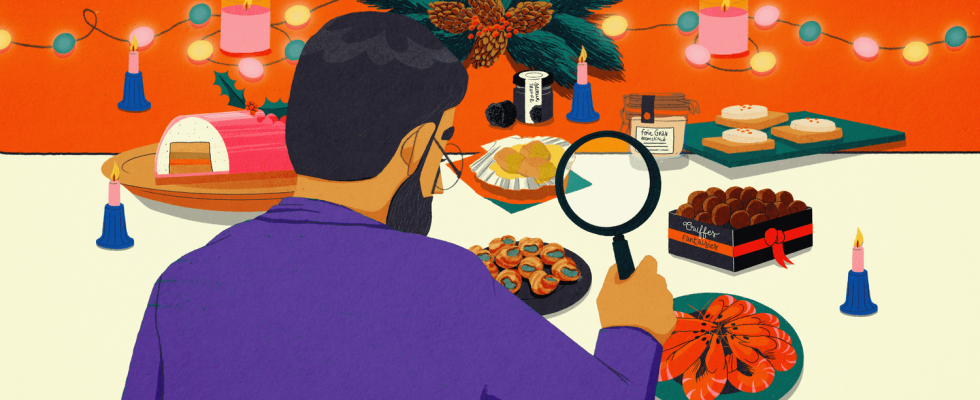On your supermarket shelves, marketing often takes precedence over quality. So, if you don’t want to be fooled, here are our tips for deciphering the labels as best as possible.
The table is set, the tablecloth ironed, the candles lit… the end-of-year holiday meals can begin ! But what will your beautiful porcelain tableware brought out for the occasion really contain? ? If you have done your shopping without being very attentive, simple scallops disguised as scallops, preparations based on foie gras full of water, pink shrimps doped with additives, Burgundy snails from Western Europe Or even an industrial Christmas log, although purchased from your artisan baker, could well be on your table.
So, while waiting for Christmas Eve, here are our tips for spotting and avoiding seven recurring pitfalls on the flagship products of the Christmas meal.
1 Scallops disguised as scallops

A beautiful ribbed shell, a fleshy nut, all browned in the oven. The Saint-Jaques is a sure value for festive tables. But if you didn’t buy it fresh, it’s quite possible that in reality you won’t taste the species you imagine. Indeed, a 1996 decree provides that all shellfish of the Pectinidae family, as long as they are preserved, frozen or in prepared meals, may be marketed under the name “Scallops”. This therefore includes a wide variety of scallop species from all over the world – with varying prices and taste qualities – and not just the Pecten maximusfished in France.
“Brands are generally not transparent and consumers mistakenly think they are buying scallops, but at a price that is indeed that of real scallops, sold twice as expensive as other scallops on the market. of Rungis”note Audrey Morice, campaigns manager at the NGO Foodwatch. Fortunately, you can make a difference ! The scientific name of the species must be written on the packaging : therefore always check that it is Pecten Maximus before putting them in your cart.
2Truffles displayed everywhere… but present (almost) nowhere

Truffle oil, truffle chips, truffle raclette, truffle hummus (Yes yes)… The gourmet mushroom has invaded supermarket shelves. But what do we really find in these party products? ? French legislation requires that any product with a “mention referring to truffle” must contain a percentage of this mushroom “greater than 1%”. To have a little more, prefer the mention “truffle”, which requires that the product contain a minimum of 3% truffle, of certain species only.
This is the second element to check: the variety of truffle used. The most famous truffles, whose taste qualities are recognized, are the black truffle or Périgord truffle. (Tuber melanosporum) as well as the white truffle from Alba or Piedmont (Tuber magnatum). Not to be confused with the white summer truffle (Tuber aestivum), less aromatic, or even Chinese truffle (Tuber indicum), much less famous. The fact remains that with only 1% truffle in their products, manufacturers often have to add flavorings to give the illusion of the famous scent. This must be specified on the packaging. But, once again, don’t be fooled: a natural flavor in a truffle product does not contain, most of the time, not a single gram of truffle !
3“Burgundy snails” from Eastern Europe
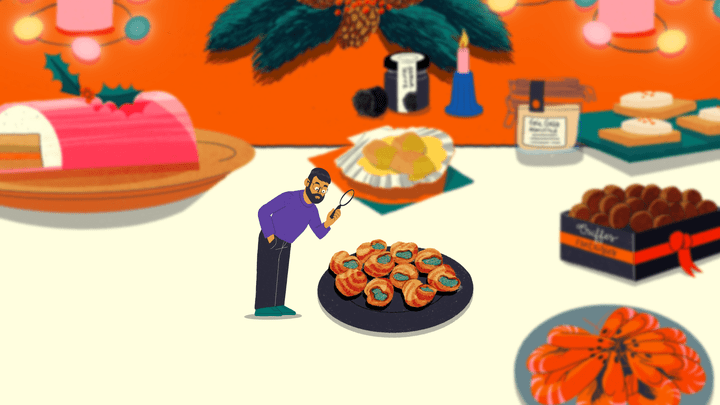
Armed with your pliers, you try to extract a Burgundy snail from its shell, buried under a layer of parsley butter. But what you may not know is that this mollusk was most likely collected far from the Burgundian hillsides, in Eastern Europe. Indeed, the name “Burgundy snail” corresponds to a species, theHelix pomatia, and not to a geographical area. Whatever its country of origin, this species can therefore be marketed under the name “Burgundy snail”. “Even the Red Label ‘Burgundy snail’ is not always Burgundian”specifies Audrey Morice, from the NGO Foodwatch.
For several decades, the Burgundy snail has actually almost disappeared from France, due to its intensive exploitation and the use of pesticides, recalls the Ministry of the Economy. The species is now protected and its collection is closely supervised by a stop. To taste French snails, focus more on petit-gris, or Helix aspersa, raised in France. And don’t be fooled by the packaging. “Traditional or regional marketing often misleads consumers about the real origin of these products, underlines Audrey Morice. These are tricolor specialties which are not so French after all…”
4Industrial Christmas logs from your artisan baker
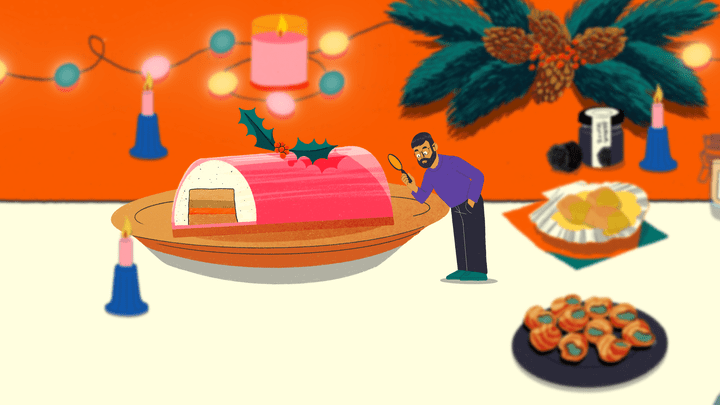
When it’s time for dessert, you take out, quite proudly, a log bought from your favorite baker. The one you see shaping and baking your traditional baguettes all day long. But for pastry, it is possible that the latter does not get his hands dirty. Indeed, if an artisan baker must respect strict rules regarding the making of bread (kneading, fermentation, shaping and baking on site), this is not the case for its pastries.
Whether for croissants or Christmas logs, a baker can sell industrial products without having to specify this to his customers. The only exception is that defrosted products must be reported, at least by a pictogram (igloo, penguin, snowflake). “In practice, very few craftsmen report this”deplores theUFC What to Choose, which has long pointed to the presence of industrial logs in bakery windows. So, to ensure the quality of your pastry, look carefully the words “homemade”.
5Pink shrimps doped with additives
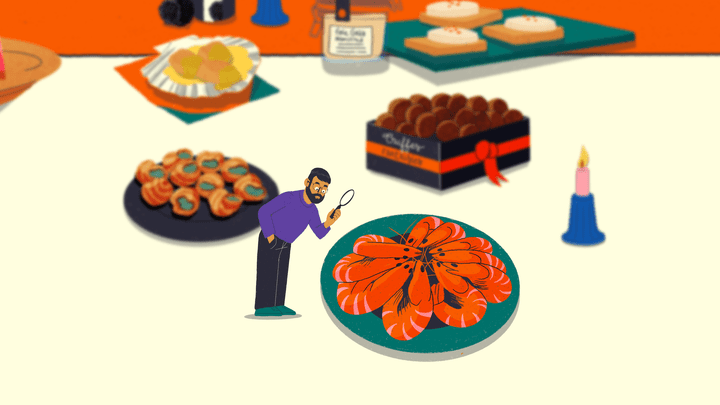
You like to tell this anecdote in front of your guests while placing the platter of shrimp and mayonnaise on the table : “You knew that raw shrimp are gray and that they turn pink when cooked ?” It always has its little effect. But what you may not know is that to maintain this immaculate pink – due to the presence of carotenoids in shrimp – manufacturers have a little trick… less appetizing. If you buy whole cooked shrimp, sodium disulfite (E223) may be hiding among the ingredients. His role ? Avoid the appearance of black spots (melanoses) which would reduce consumers’ appetite for this festive product, explains France 5.
“It is a cosmetic manipulation, while this additive has controversial effects on human health,” Audrey Morice is alarmed. Indeed, “EFSA experts concluded that the ingestion of sulphites through food could pose a safety problem for large consumers of foods containing these additives”underlines the European Food Safety Authority. So, it is better to avoid them and explain to your guests that the small black spots on your shrimp in no way affect their taste and quality. !
6Foie gras stuffed with water
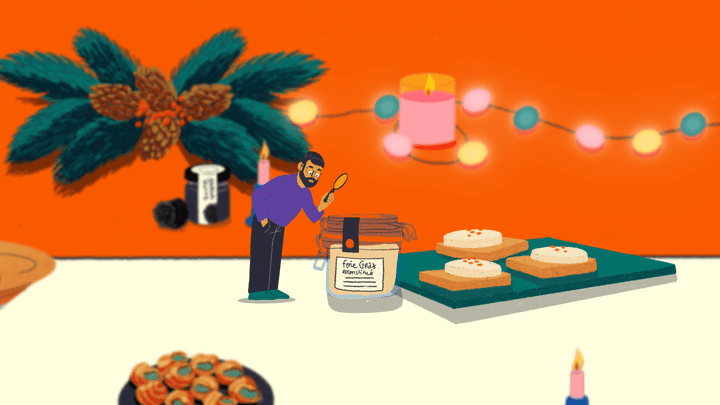
As Christmas approaches, supermarket shelves are filled with foie gras in all forms. It’s not easy to make your choice. But behind each denomination hide strict rules who can help you. Let’s get straight to the point : “whole foie gras” is the noblest (and often the most expensive), since it is exclusively one or more lobes of seasoned foie gras. Nothing else. Without the term “whole”, the lobes may be clumped together. Then the list of other ingredients starts to grow. The “block of foie gras” is emulsified with up to 10% water; the “foie gras parfait” can contain up to 25% lean liver; the “medallion”, the “pâté”, the “galantine” or the “mousse” only contain at least 50% foie gras.
But beyond the labels, some manufacturers are not shy about cheating. No less than 75% of foie gras products were “non-compliant” with the legislation during the latest fraud prevention checks. According to the DGCCRF, Many manufacturers of foie gras blocks tend to add too much water to their products.
7 “Fancy truffles” with chocolate… and palm oil

To end the meal, nothing better than a little touch of chocolate… and palm oil ? This is often what is hidden in packets of “fancy truffles”. Because this term is not simply written on the packaging to mark the originality of the chocolates. This is a mandatory legal name for manufacturers who want to sell chocolate truffles made with “vegetable fats, other than cocoa butter”remember the Ministry of the Economy.
A subtlety that manufacturers try to make you forget on the packaging, as with these fancy truffles highlighted by Foodwatch. “There is a gap between the marketing, which highlights ethically sourced cocoa, and inside, the first ingredient which is palm oil, explains Audrey Morice. A fat that is extremely harmful to the environment, health and human rights.”

